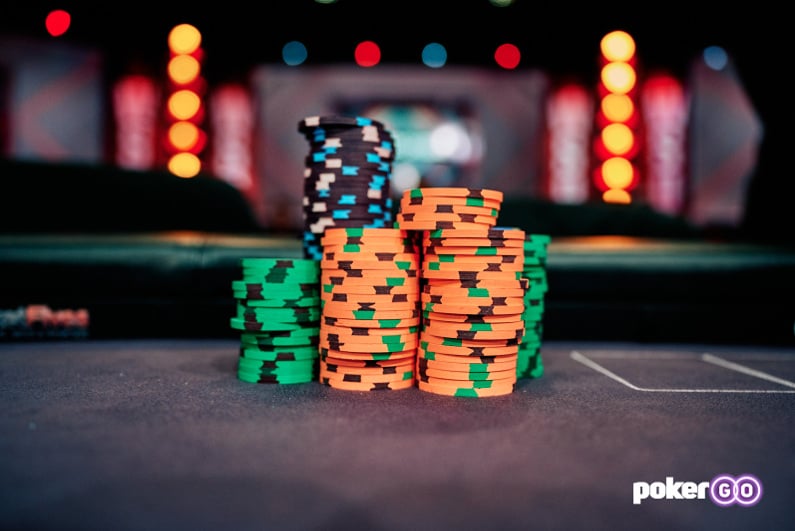
Target Stack satellite strategy
My co-author Barry Carter tells a funny story about his first book, The Mental Game of Poker, co-authored with Jared Tendler. They were all set for a big launch day….on Black Friday, the day online poker in the US was effectively shut down by the Feds. Thankfully it proved just a temporary blip in what became the biggest selling poker book of the last decade.
everything in the book still holds true for Target Stack satellites
Back in 2019, Barry had a feeling of deja vu on the day Poker Satellite Strategy, his first book with me, launched. A new type of satellite was unveiled in the US, and in fact the first few responses we got to the announcement were queries as to whether the new format rendered our book redundant. Our initial fears that this might be the case dissipated for two reasons. First, while this new “Target Stack” format gained some popularity, most notably with PokerStars, they gained no traction online and even live, most satellites remained the familiar old super satellite that the book delves into in considerable detail. And second, it turns out that everything in the book still holds true for Target Stack satellites. In fact, Target Stack satellites don’t complicate the strategy, they actually simplify it, as I will explain in this article.
The differences
So what are the differences? Instead of the more common satellite format in which x number of players win a seat by surviving the bubble, a player wins their seat in a Target Stack satellite when their stack gets to a certain size: the target stack. Let’s say 30 players enter the tournament with 1,000-chip starting stacks and one player in ten gets a seat. In the old satellite format, three players win their seat when 27 players are eliminated. Qualifiers could have a 20,000 stack or literally just an ante. It wouldn’t matter. In the new format, each player would win a seat when they get their stack to 10,000 chips or more, regardless of when that happens. They could literally win their seat in the first orbit.
there is no point in stalling in these events
This format initially proved very popular when I saw it at EPT Prague a few years ago because it addresses a number of issues with traditional super satellites, such as stalling and having to play long after you’ve effectively locked up a seat. There is no point in stalling in these events, an obvious benefit. You can win your seat quickly too, which is much nicer and also good for liquidity in general if it means players can register for the target event sooner. There are some big strategic adjustments required compared with regular satellites, where survival is key. It doesn’t matter how big your stack is if you beat the bubble in normal satellites, so in those tournaments, a big stack can exert ICM pressure on short stacks, desperate to survive.
Reverse ICM
The opposite is true in this new format. The chip leaders are the players with everything to lose and little to gain. If the target is 10k and you have 9,000 chips in the example above and a shorter stack shoves for 4,000, you really don’t want to call and risk the gains you have already made. It really is a format where the short stacks can pressure the big stacks.
In Poker Satellite Strategy, we introduced a new concept called COC (chance of cashing), which is by far the single most important concept in satellites. We explained a couple of different ways you can use what we call gorilla maths at the table to estimate your COC at any point. Early in the tournament, we have to work out what the average stack will be when the bubble bursts, and our COC at this stage is best estimated as the percentage of the target stack we have. To continue a similar example as above, if starting stack is 1,000 chips and one in ten players win a seat, the average stack when the bubble bursts will be 10,000. If we double up early to 2,000 chips, our COC increases from 10% to 20%.
Near the bubble (of a traditional satellite), things get much more complicated. Typically, some players will have more than the target stack at this point. To continue the example, say we started with 30 runners and there are three seats, and starting stack is 1,000 chips, we use 10,000 as the target to assess our COC early on. But let’s say on the bubble with four left, the two chip leaders have 14,000 chips each and the two short stacks only 1,000. The chip leaders are all but locked up unless they do something stupid against each other, but they can only win one seat, so their COC is capped at 1. This leaves the two shorties who have only 10% of the target, effectively in a dog fight for the last seat. In this case, 10% of starting stack equates to a COC of 50%.
The gorilla maths of working out bubble COCs can be quite complicated and a significant chunk of Poker Satellite Strategy is devoted to how to work it out at the table. The good news if you’re playing a target stack satellite is you don’t need to even read this section of the book because you don’t need to do that maths: your COC is always your current percentage of the target stack (one minor exception to this is in some target satellites excess chips over the target are taken out of play rather than redistributed meaning the last couple of seats are allocated to the last surviving players even though they haven’t reached the target).
How the strategy changes
Until you get to 50% of your target stack, the strategy is essentially ChipEV, i.e., there is no ICM pressure on you. You should play your hands exactly as you would in a cash game and not pass any profitable spots. However, as in the example above, you can exert ICM pressure on players who are near to the target stack. Get above 50% of the target, however, and you have to tighten up. Below 50% you only need 50% equity to break even against any player, but after that the equity you need to put all your chips at risk is the percentage of the target stack you currently have. If you have 75% of the target stack you need 75% equity to justify risking losing all these chips. The worst spot is if you are almost there with 95% equity as you would need 95% equity to risk your chips and no starting hand has that much of an advantage. Even shorter stacks can exert significant pressure.
the better a player does, the easier it is for the player behind to get back in the game
This is where a short stack can pressure a big stack. This is what is known as a “rubber band effect” in games, where the better a player does, the easier it is for the player behind to get back in the game (pool is a good example of this). Let’s say a shorty has 1,000 chips and the chip leader has 9,800. The short stack is only risking one buy-in’s worth of chips if they shove into the chip leader. If the leader calls they can only win 200 chips but are risking 1,000, so they would need 80% equity to justify the call. That is usually only aces. In the example above, if the leader called and won, they would only win the 200 chips they need for a seat and the remaining chips would be redistributed back into the tournament. The PokerStars version redistributes them equally among the other players at the table.
At some point, the chip leader has to acknowledge to themselves that they will need to take a worse-than-ICM spot to get over the line. They might need 2-to-1 equity but decide that taking a 60/40 is their best chance at winning a seat, otherwise they risk sliding back down the chip rankings. The best time for anyone to win a seat is when they have exactly 50% of the target stack. A double up now will win them a seat and they only need 50% equity to justify risking elimination.
Bounty satellites
This is an even newer format where to encourage players to play looser, there is a bounty element. This might fix the tough spot the chip leaders find themselves in. If the buy-in was €1,100 with a €500 bounty to win a €5,000 seat, the bigger stacks can keep ploughing ahead and playing loose to also win the bounties. If a player with 75% of the target can pick up €1,500 in bounties on their way to the target, they have a reason not to play so tight. It’s very much in my interest to rail against a format like this because I am the author of Poker Satellite Strategy, which covers everything you need to know about the traditional satellite format.
However, I really like this new format and think it could prove popular. I think the format will need a few tweaks before it reaches a final form and perhaps the traditional format is much better suited to recreational players because this “chip accumulation” format suits professionals more. Either way, it’s good for poker when formats change to keep them fresh and tough to solve, and I look forward to playing more Target Stack satellites in the future.
- SEO Powered Content & PR Distribution. Get Amplified Today.
- EVM Finance. Unified Interface for Decentralized Finance. Access Here.
- Quantum Media Group. IR/PR Amplified. Access Here.
- PlatoAiStream. Web3 Data Intelligence. Knowledge Amplified. Access Here.
- Source: https://www.vegasslotsonline.com/news/2023/06/21/target-stack-satellite-strategy-gives-power-to-the-short-stack/
- 000
- 1
- 10
- 100
- 14
- 20
- 200
- 2019
- 27
- 30
- 500
- 9
- a
- About
- above
- ACES
- actually
- addresses
- adjustments
- ADvantage
- after
- Against
- ago
- ahead
- All
- allocated
- already
- also
- always
- am
- among
- an
- and
- Announcement
- any
- anyone
- ARE
- article
- as
- assess
- At
- author
- average
- back
- band
- BE
- became
- because
- before
- behind
- below
- benefit
- BEST
- Better
- BIG
- bigger
- Biggest
- Black
- Black Friday
- book
- bounties
- bounty
- break
- bubble
- but
- by
- call
- called
- calls
- CAN
- case
- Cash
- cash game
- cashing
- certain
- chance
- change
- chip
- Chips
- Common
- compared
- complicated
- concept
- considerable
- continue
- could
- Couple
- covers
- Current
- currently
- day
- decade
- decide
- detail
- differences
- different
- do
- does
- dog
- double
- down
- e
- each
- Early
- easier
- effectively
- either
- element
- encourage
- Enter
- EPT
- equally
- equates
- equity
- Essentially
- estimate
- estimated
- even
- Event
- events
- everything
- exactly
- Example
- exception
- excess
- explain
- explained
- fact
- familiar
- far
- fears
- few
- fight
- Final
- find
- First
- Fix
- For
- form
- format
- Forward
- four
- fresh
- Friday
- from
- funny
- future
- gain
- gained
- gains
- game
- Games
- General
- Get
- gives
- good
- had
- hand
- hands
- happens
- has
- Have
- having
- his
- holds
- How
- How To
- however
- HTTPS
- i
- if
- important
- in
- increases
- initial
- initially
- instead
- interest
- into
- introduced
- Is
- issues
- IT
- jpg
- just
- keep
- Key
- know
- known
- last
- launch
- launched
- leader
- leaders
- left
- like
- Line
- Liquidity
- Little
- Live
- locked
- Long
- Look
- lose
- losing
- made
- matter
- me
- meaning
- means
- might
- minor
- more
- most
- much
- my
- Near
- need
- New
- news
- no
- normal
- not
- notably
- now
- number
- obvious.
- of
- Old
- on
- One
- online
- online poker
- only
- opposite
- or
- Orbit
- Other
- otherwise
- our
- out
- over
- pass
- percentage
- perhaps
- pick
- plato
- plato data intelligence
- platodata
- platogaming
- play
- player
- players
- Playing
- Point
- Poker
- PokerStars
- pool
- Popular
- popularity
- power
- prague
- pressure
- professionals
- Profitable
- prove
- proved
- put
- queries
- quickly
- quite
- Rail
- rankings
- rather
- reaches
- read
- really
- reason
- reasons
- Recreational
- regardless
- register
- regular
- remained
- required
- responses
- Risk
- satellite
- Satellites
- saw
- say
- SEAT
- second
- section
- selling
- set
- Short
- should
- significant
- similar
- single
- Size
- sliding
- So
- SOLVE
- some
- something
- Spot
- stack
- Stage
- started
- Starting
- still
- Story
- Strategic
- Strategy
- such
- super
- Survival
- survive
- table
- Take
- taken
- taking
- Target
- tells
- temporary
- ten
- than
- that
- The
- The Future
- The Game
- their
- Them
- themselves
- there
- These
- they
- things
- think
- this
- those
- though
- three
- time
- to
- too
- tough
- tournament
- Tournaments
- traction
- traditional
- true
- turns
- two
- type
- typically
- unveiled
- up
- us
- use
- usually
- version
- very
- want
- was
- way
- ways
- we
- were
- What
- What is
- when
- where
- whether
- while
- WHO
- will
- win
- winning
- Wins
- with
- Work
- work out
- working
- working out
- worst
- worth
- would
- X
- years
- you
- your
- zephyrnet










